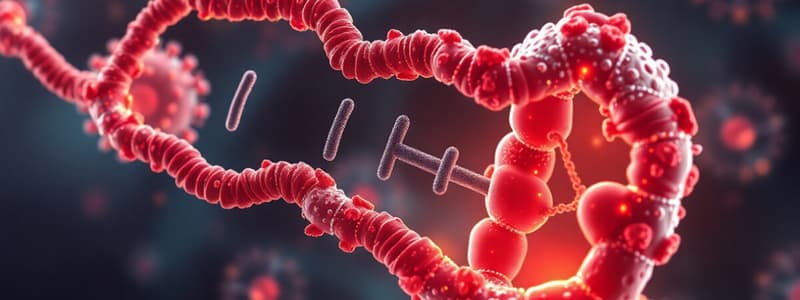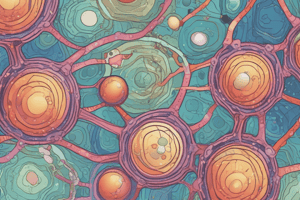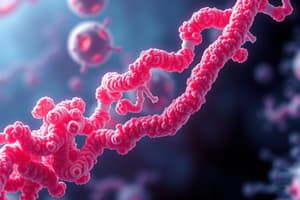Podcast
Questions and Answers
Which site on the ribosome is primarily responsible for holding the newly arriving tRNA during elongation?
Which site on the ribosome is primarily responsible for holding the newly arriving tRNA during elongation?
- E site
- R site
- P site
- A site (correct)
Which mechanism primarily controls the expression of genes in the lac operon?
Which mechanism primarily controls the expression of genes in the lac operon?
- Positive regulation by activators only
- Negative regulation by repressors only
- Transcriptional enhancement by ribosomes
- Repression and activation mechanisms (correct)
During termination of translation, what is primarily responsible for recognizing the stop codon?
During termination of translation, what is primarily responsible for recognizing the stop codon?
- Elongation factors
- tRNA molecules
- Ribosome's A site
- Release factors (correct)
In which phase of translation do peptide bonds form between amino acids?
In which phase of translation do peptide bonds form between amino acids?
Which of the following statements about the ribosome's E, P, and A sites is true?
Which of the following statements about the ribosome's E, P, and A sites is true?
How does lactose affect the transcription of the lac operon?
How does lactose affect the transcription of the lac operon?
What is the role of chaperones in protein synthesis?
What is the role of chaperones in protein synthesis?
What would be the result of a mutation that prevents the ribosome from properly releasing tRNA?
What would be the result of a mutation that prevents the ribosome from properly releasing tRNA?
Which of the following accurately describes the role of transcriptional activators in relation to histone modification?
Which of the following accurately describes the role of transcriptional activators in relation to histone modification?
What is the effect of histone deacetylases (HDACs) on transcription?
What is the effect of histone deacetylases (HDACs) on transcription?
Which of the following statements regarding chromatin states is true?
Which of the following statements regarding chromatin states is true?
In cells where Gene X is expressed in the brain but not in muscle, which of the following is most likely true?
In cells where Gene X is expressed in the brain but not in muscle, which of the following is most likely true?
What modification directly impacts DNA in addition to histone changes?
What modification directly impacts DNA in addition to histone changes?
What role do tRNAs play in the process of translation?
What role do tRNAs play in the process of translation?
During translation initiation, what is the first interaction that occurs?
During translation initiation, what is the first interaction that occurs?
What differentiates the initiation of translation between prokaryotic and eukaryotic cells?
What differentiates the initiation of translation between prokaryotic and eukaryotic cells?
What is the end point of translation marked by?
What is the end point of translation marked by?
How can translation of mRNAs be regulated?
How can translation of mRNAs be regulated?
What is a characteristic of prokaryotic mRNAs?
What is a characteristic of prokaryotic mRNAs?
What is the role of the large ribosomal subunit in translation?
What is the role of the large ribosomal subunit in translation?
What event marks the elongation phase of translation?
What event marks the elongation phase of translation?
Flashcards are hidden until you start studying
Study Notes
Translation
- tRNAs serve as adaptors that align amino acids on the mRNA template during translation.
- Ribosomes, made of both structural rRNA and catalytic proteins, catalyze peptide bond formation during translation.
- Translation initiation differs in prokaryotes and eukaryotes.
- Prokaryotes lack a nucleus, so translation can begin while genes are transcribed.
- In both prokaryotes and eukaryotes, the small ribosomal subunit and initiator tRNA first interact with mRNA before the large ribosomal subunit joins.
- Translation begins at a start codon (AUG) and ends at a stop codon (UAA, UAG, UGA).
- Translation can be regulated by repressor proteins and miRNAs.
- Repressor proteins bind to mRNA, preventing translation.
- MicroRNAs can bind to mRNA, leading to degradation or inhibiting translation.
- Global translational activity can be regulated by modification of translation initiation factors.
Translation Initiation in Prokaryotes
- Shine-Dalgarno sequence: A purine-rich sequence upstream of the start codon that helps align the ribosome.
Translation Initiation in Eukaryotes
- eIFs (eukaryotic initiation factors): Proteins that help facilitate the initiation process.
- 5' cap and 3' poly-A tail: Eukaryotic mRNAs have a 5' cap and 3' poly-A tail that are recognized by eIFs.
- Small subunit + eIFs + GTP-bound initiator tRNA: This complex binds to the 5' cap and scans for the start codon.
- **Hydrolysis of GTP bound to eIFs:**Releases initiation factors.
- Binding of the large ribosomal subunit: Forms the initiation complex.
Translation Elongation
- E, P, and A sites: Three sites on the ribosome where tRNA molecules bind and move through during translation.
- A (aminoacyl) site: Where a charged tRNA binds.
- P (peptidyl) site: Where the growing polypeptide chain is attached to the tRNA.
- E (exit) site: Where an uncharged tRNA exists the ribosome.
Translation Termination
- Release factors: Proteins that recognize stop codons and trigger the release of the polypeptide chain from the ribosome.
- Stop codon: Signals the end of translation.
Functional Proteins
- Polypeptides are not automatically functional proteins.
- They may require:
- Lipid modification
- Chaperone proteins
- Enzyme activity
- Disulfide bond formation
Gene Regulation in E. coli
- Lac operon: A model system for gene regulation in bacteria, controlled by positive and negative mechanisms.
- Lac operon is negatively regulated by a repressor protein.
- The repressor protein binds to the operator sequence, blocking RNA polymerase from binding and transcribing the genes.
- Lac operon is positively regulated by an activator protein.
- The activator protein binds to the promoter sequence, increasing the affinity of RNA polymerase for the DNA.
DNA Packaging
- DNA is packaged into chromatin.
- DNA is wrapped around proteins called histones to form nucleosomes, the basic structural unit of chromatin.
- Euchromatin: Loosely packed chromatin, typically associated with active genes.
- Heterochromatin: Tightly packed chromatin, typically associated with inactive genes.
Histone Modification
- Histones can undergo modifications (acetylation, methylation) to promote open euchromatin or closed heterochromatin.
- Acetylation: The addition of acetyl groups to histone tails, typically associated with open chromatin.
- Acetyl groups are added by histone acetyltransferases (HATs).
- Deacetylation: Removal of acetyl groups from histone tails, typically associated with closed chromatin.
- Acetyl groups are removed by histone deacetylases (HDACs).
- Methylation: The addition of methyl groups to histone tails, can either activate or repress gene expression depending on the specific amino acid residue and the number of methyl groups added.
- Other factors influence chromatin structure:
- DNA methylation
- Non-histone proteins
Transcriptional Regulation
- Transcriptional regulators bind to DNA and can activate or repress gene expression.
- Activators:
- Increase transcription by promoting the interaction of RNA polymerase with the promoter.
- Associate with HATs, leading to increased acetylation.
- Repressors:
- Decrease transcription by blocking RNA polymerase from binding to the promoter.
- Associate with HDACs, leading to decreased acetylation.
Studying That Suits You
Use AI to generate personalized quizzes and flashcards to suit your learning preferences.




